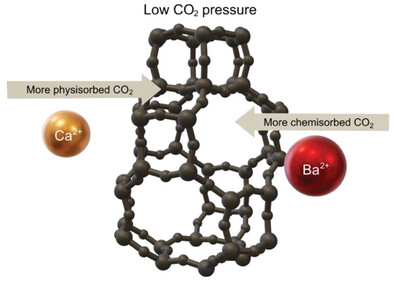Ask for a reprint
email :
* Give your email
2023
ACL
|
Aymeric Magisson, Edwin B.Clatworthy, Sajjad Ghojavand, Philippe Bazin, Valérie Ruaux, Eddy Dib, Svetlana Mintova, 'CO2 Adsorption Behavior of Nanosized CHA Zeolites Synthesized in the Presence of Barium or Calcium Cations', Adv. Sustainable Syst. 2300326 1-9 (2023) doi:10.1002/adsu.202300326
Alkaline-earth metal cations impact the rate of crystallization and the adsorption of N2 and CO2 on nanosized chabazite zeolites. In this study, either calcium or barium is added to precursor mixtures containing alkali-metal cations (Na+, K+, Cs+) to prepare chabazite (labeled Ca-CHA and Ba-CHA), and are compared to a reference sample (Ref-CHA) synthesized using exclusively Na+, K+, and Cs+. Partial substitution of the Na+ and the pore-blocking Cs+ extra-framework cations is observed for Ca-CHA depending on the molar ratio of K2O used in the synthesis, while a change to the amount of Na+ cations only is observed for Ba-CHA. The type of alkaline-earth metal cation affects the crystallization rate; slower in the presence of Ca2+ (10 h to full crystallinity) and similar rates in the presence of Ba2+ (4 h to full crystallinity); the crystallite size and morphology remained similar. The presence of Ca2+ or Ba2+ extra-framework cations leads to N2 uptake values of 290 and 169 mmol g−1 (−196 °C, 100 kPa), respectively, while at low CO2 pressure (<1 kPa, 25 °C), the physisorbed CO2 capacity for Ref-CHA, Ca-CHA, and Ba-CHA zeolites is 0.63, 0.66, and 0.59 mmol g−1, respectively. Interestingly, an opposite effect is observed for the amount of chemisorbed CO2 species.
|

|